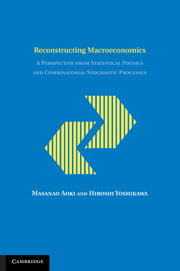 Reconstructing Macroeconomics
Reconstructing Macroeconomics Book contents
- Frontmatter
- Contents
- Preface by Masanao Aoki
- Preface by Hiroshi Yoshikawa
- 1 Introduction: A New Approach to Macroeconomics
- 2 The Methods: Jump Markov Process and Random Partitions
- 3 Equilibrium as Distribution: The Role of Demand in Macroeconomics
- 4 Uncertainty Trap: Policy Ineffectiveness and Long Stagnation of the Macroeconomy
- 5 Slow Dynamics of Macro System: No Mystery of Inflexible Prices
- 6 Business Cycles: An Endogenous Stochastic Approach
- 7 Labor Market: A New Look at the Natural Unemployment and Okun's Law
- 8 Demand Saturation-Creation and Economic Growth
- 9 The Types of Investors and Volatility in Financial Markets: Analyzing Clusters of Heterogeneous Agents
- 10 Stock Prices and the Real Economy: Power-Law versus Exponential Distributions
- References
- Author Index
- Subject Index
- Other books in the series (continued from page iii)
10 - Stock Prices and the Real Economy: Power-Law versus Exponential Distributions
Published online by Cambridge University Press: 08 August 2009
- Frontmatter
- Contents
- Preface by Masanao Aoki
- Preface by Hiroshi Yoshikawa
- 1 Introduction: A New Approach to Macroeconomics
- 2 The Methods: Jump Markov Process and Random Partitions
- 3 Equilibrium as Distribution: The Role of Demand in Macroeconomics
- 4 Uncertainty Trap: Policy Ineffectiveness and Long Stagnation of the Macroeconomy
- 5 Slow Dynamics of Macro System: No Mystery of Inflexible Prices
- 6 Business Cycles: An Endogenous Stochastic Approach
- 7 Labor Market: A New Look at the Natural Unemployment and Okun's Law
- 8 Demand Saturation-Creation and Economic Growth
- 9 The Types of Investors and Volatility in Financial Markets: Analyzing Clusters of Heterogeneous Agents
- 10 Stock Prices and the Real Economy: Power-Law versus Exponential Distributions
- References
- Author Index
- Subject Index
- Other books in the series (continued from page iii)
Summary
This final chapter explores the relationship between stock prices and the real economy. The standard approach – the so-called consumption-based asset pricing model – attempts to explain it based on the assumption of the representative agent. In this chapter, we argue once again that the representative agent assumption is fundamentally flawed. Drawing on the recent advancement of “econophysics” on financial markets, we argue that in contrast to the neoclassical view, there is in fact a wedge between financial markets, the stock prices in particular, and the real economy.
Introduction
Stock prices depend necessarily on the real economy. Their “correct” prices or the fundamental values are the discounted present values of a stream of future dividends/profits. Because business activities, profits in particular, are significantly affected by the state of the real economy, the stock prices are also affected by the real economy. More precisely, in the standard neoclassical theory, stock prices are simultaneously determined with all the supplies and demands in general equilibrium (Diamond, 1967). Thus, like production and consumption, the stock prices depend ultimately on preferences and technologies.
However, there is a long tradition in economics which questions whether the stock prices are really determined in the way stated above. Many believe that “bubbles” are possible in the market. And whether or not they are “rational,” extraordinary changes in the stock prices (either up or down) by themselves may do harm to the real economy They are not a mere mirror image of the real economy.
- Type
- Chapter
- Information
- Reconstructing MacroeconomicsA Perspective from Statistical Physics and Combinatorial Stochastic Processes, pp. 275 - 308Publisher: Cambridge University PressPrint publication year: 2006


